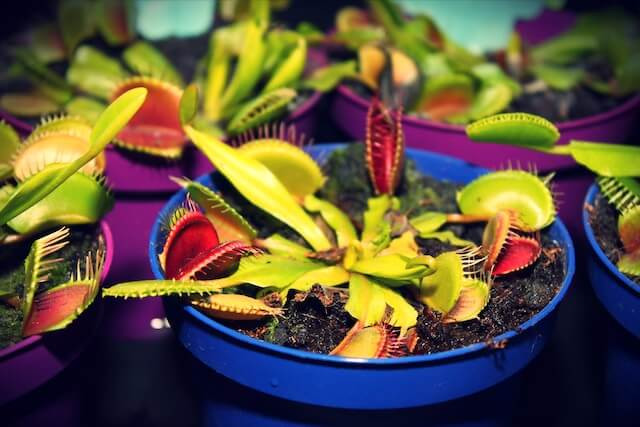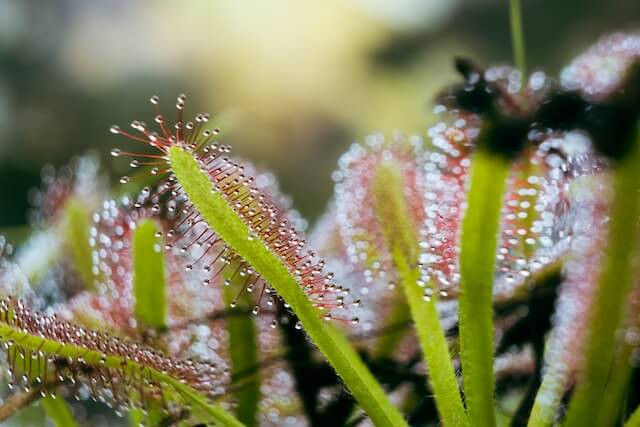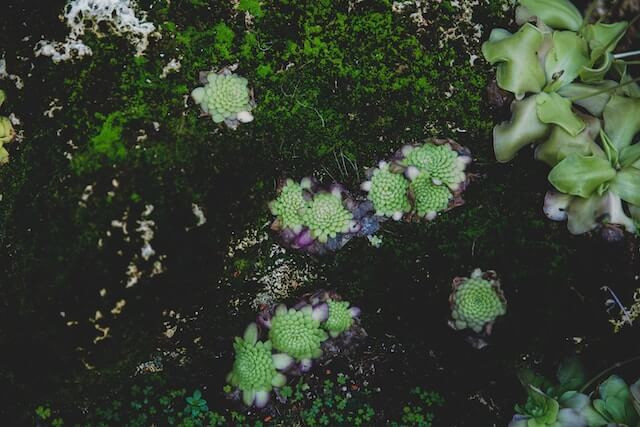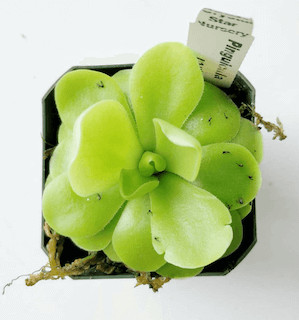Will Venus Fly Traps Eat Gnats? Yes, Venus flytraps can indeed eat gnats, especially the younger ones with smaller traps, and at flyermedia.net, we will explore the carnivorous world of Venus flytraps and their gnat-eating habits. However, whether they are the most efficient solution for a gnat infestation is another question, we provide the solution for optimal nutrition intake for growth and development for these fascinating plants. Explore our site for comprehensive guides on carnivorous plant care, pest control tips, and the best species for your needs, let’s uncover the best methods for feeding your carnivorous plants!
1. Do Venus Fly Traps Eat Gnats?
 venus flytraps in blue and purple pots
venus flytraps in blue and purple pots
Yes, Venus flytraps do eat gnats, but the size of the trap is a major consideration. Younger Venus flytraps, around one to two years old, with smaller traps (lobes) are more likely to capture gnats. Larger, more mature Venus flytraps have bigger lobes, and gnats and fruit flies might be too small to activate the plant’s trigger hairs. While a Venus flytrap would certainly consume fungus gnats, the insects might not be large enough to trigger the traps.
For those dealing with a fungus gnat infestation, plants like sundews or butterworts may be more effective carnivorous solutions. To know more, visit flyermedia.net.
2. Why Do Venus Flytraps Eat Gnats and Other Insects?
Venus flytraps thrive in nutrient-poor environments where traditional nutrients like nitrogen are scarce. To adapt, they evolved into carnivores. Trapping and digesting insects like gnats, fruit flies, moths, beetles, and spiders allows Venus flytraps to supplement their diet with essential nutrients obtained from their prey.
Once a trap closes, the digestion process starts. The Venus flytrap releases digestive enzymes, similar to those in a human stomach, which break down the insect. After a week, the trap reopens, revealing the indigestible exoskeleton. Because of their small size, gnats might not leave any noticeable remains.
3. Can a Diet of Only Gnats Sustain a Venus Flytrap?
Gnats can be part of a Venus flytrap’s diet, but they cannot be its sole source of nutrition. Fungus gnats are small and offer fewer nutrients than larger insects. A healthy Venus flytrap diet should include a variety of insects for optimal nutrient intake.
4. How Do Venus Flytraps Digest Gnats and Other Bugs?
Venus flytraps are carnivorous plants with a unique feeding mechanism. The traps have sensitive hairs that trigger the trap to snap shut within a fraction of a second when an insect is present. This rapid movement results from changes in internal cell pressure.
The inner surface of the lobes secretes digestive enzymes once the Venus flytrap lobes close, breaking down the insect’s soft tissues into essential nutrients. Since this carnivorous plant grows in nutrient-poor environments, Venus flytraps primarily rely on insects as their source of nitrogen.
5. What Insects Do Venus Flytraps Eat?
The Venus flytrap diet consists of ants, beetles, spiders, and other crawling arthropods. However, they aren’t picky eaters. The carnivorous plant will find a gnat just as appealing if it lands on a Venus flytrap and triggers the trap to close.
These plants use a unique trapping mechanism involving modified leaves that snap shut when triggered by prey. The trap will close and seal the insect inside if a gnat or any insect touches the sensitive hairs inside the trap twice within about 20 seconds.
A varied diet is essential for the health and well-being of Venus flytraps. A varied diet ensures access to a wide range of nutrients, promoting optimal growth and development.
6. What Are The Best Gnat-Eating Carnivorous Plants?
Don’t panic if you have a fungus gnat infestation. Carnivorous plants will gladly come to your rescue and are more effective than sticky traps.
While a smaller Venus flytrap may eat some gnats, other carnivorous plants are better options. To get rid of fungus gnats quickly and easily, consider these carnivorous plant options:
6.1. Sundews (Drosera)
 drosera sundews eat gnats and fruit flies
drosera sundews eat gnats and fruit flies
Sundews (Drosera) are an excellent choice for eliminating a fungus gnat problem and will also consume fruit flies. These plants have tentacle-like structures covered in a sticky substance that traps insects landing on them.
The sticky dew ensnares the gnat, and the sundew plant’s enzymes slowly digest it. Sundews come in different shapes and sizes, but all are highly effective at catching gnats.
If you’re new to sundews, try the Cape sundew (Drosera capensis), an excellent plant for beginners. It’s adorable and great at eating gnats.
6.2. Butterworts (Pinguicula)
Butterworts, which resemble cute, carnivorous succulents, are great at eliminating fungus gnats. To catch gnats and fruit flies, these plants use a flypaper trap mechanism. Their leaves secrete a sticky substance that attracts and traps insects.
The leaf slowly rolls inwards to encase the prey and begin digestion once a gnat is stuck. Butterworts are particularly effective at catching small flying insects like gnats and fruit flies, so you won’t have the same trap-triggering issues as with Venus flytraps.
6.3. Bladderworts (Utricularia)
 bladderworts are a carnivorous plant that eats gnats
bladderworts are a carnivorous plant that eats gnats
Bladderworts are aquatic or semi-aquatic carnivorous plants that use suction traps to catch their prey. While they’re more known for catching tiny aquatic organisms, some terrestrial species can catch small flying insects like gnats and fruit flies. Bladderworts aren’t as easy to grow as sundews and butterworts, but they do like to feast on gnats.
7. How To Get Rid of Gnats With Carnivorous Plants
There’s nothing worse than a fungus gnat infestation in your houseplants. While Venus flytraps do eat gnats, they aren’t as effective as sundews and butterworts.
Keep your Venus flytrap happy by feeding it beetles, moths, and spiders, and let your other carnivorous plants handle the gnats.
8. Understanding E-E-A-T and YMYL in Carnivorous Plant Care
Adhering to E-E-A-T (Experience, Expertise, Authoritativeness, and Trustworthiness) and YMYL (Your Money or Your Life) standards is crucial when providing information about carnivorous plants. These guidelines ensure that the content is not only accurate and reliable but also presented in a way that promotes the well-being of both the plants and the people who care for them. Here’s how these principles are applied in the context of Venus flytraps and gnat control:
- Experience: Sharing practical, hands-on advice from personal experience in growing Venus flytraps and managing gnat infestations.
- Expertise: Demonstrating a deep understanding of carnivorous plant biology, their specific dietary needs, and effective pest management strategies.
- Authoritativeness: Citing reputable sources, such as scientific studies and expert opinions, to support claims and recommendations.
- Trustworthiness: Providing transparent, honest, and unbiased information, acknowledging any limitations in knowledge or potential risks associated with certain care practices.
By adhering to these principles, flyermedia.net aims to establish itself as a trustworthy and authoritative resource for carnivorous plant enthusiasts, ensuring that readers receive accurate and helpful information to enhance their plant care journey.
9. Using flyermedia.net for All Your Aviation and Botany Needs
At flyermedia.net, we provide various information, from aviation insights to botanical guides. Whether you’re an aviation enthusiast or a plant lover, our website has something for everyone. For aviation, explore our articles on flight training, airline careers, and aviation technology. For botany enthusiasts, discover guides on caring for carnivorous plants, pest control, and plant nutrition.
We aim to offer accurate, engaging, and up-to-date content. Our team is dedicated to providing quality information on all topics. Visit flyermedia.net today to learn more and explore the world of aviation and botany.
10. FAQ About Venus Fly Traps and Gnats
10.1. What bugs can I feed my Venus flytrap?
Venus flytraps can eat insects and arachnids, including flies, beetles, spiders, and ants. The insect should be no larger than one-third the size of the plant’s trap.
10.2. Are Venus flytraps good for pest control?
While Venus flytraps are fascinating plants that capture and eat insects, they’re not effective for pest control. Each trap can only catch and digest a few insects before it dies and a new one grows. They also require specific care conditions, which might make them less practical as pest control solutions.
10.3. What plant kills gnats?
Several carnivorous plants are effective at catching and killing gnats, including sundews, butterworts, and bladderworts. Sundews and butterworts, with their sticky leaves, are effective against gnats and easy to grow for beginners.
 bladderworts are a carnivorous plant that eats gnats
bladderworts are a carnivorous plant that eats gnats
10.4. How hard is it to keep a Venus flytrap alive?
Venus flytraps aren’t necessarily difficult to care for, but they have specific needs. They require lots of light, a humid environment, and a dormant period in the winter. They also require a specific type of soil (a mix of sphagnum peat moss and sand or perlite) and distilled water or rainwater, as tap water often contains minerals that can harm the plant. If you can provide these conditions, a Venus flytrap can thrive under your care.
10.5. How often should I water my Venus flytrap?
Water your Venus flytrap when the soil feels slightly dry to the touch. Keep the soil consistently moist but not waterlogged. During the growing season (spring and summer), this may mean watering every few days. In the winter, when the plant is dormant, you can reduce watering to once every week or two. Always use distilled water, rainwater, or reverse osmosis water to avoid mineral buildup in the soil.
10.6. What type of soil is best for Venus flytraps?
Venus flytraps require nutrient-poor, acidic soil. The best soil mix is a combination of sphagnum peat moss and perlite or sand, in a 1:1 ratio. Avoid using potting mixes that contain fertilizers or minerals, as these can harm the plant.
10.7. How much sunlight does a Venus flytrap need?
Venus flytraps need at least 6 hours of direct sunlight per day. If you’re growing your plant indoors, place it near a sunny window or use a grow light to ensure it gets enough light. Insufficient light can lead to weak growth and a lack of vibrant color.
10.8. Do Venus flytraps need dormancy?
Yes, Venus flytraps require a dormancy period in the winter to survive long-term. This typically lasts for about 3-4 months. During dormancy, the plant should be kept in a cool location (between 35-50°F or 2-10°C) with reduced watering. The leaves may turn black and die back, but this is normal.
10.9. Can I trigger the traps of my Venus flytrap manually?
While it’s tempting to trigger the traps of your Venus flytrap, doing so excessively can weaken the plant. Each trap can only open and close a limited number of times (usually around 3-5 times) before it dies. Only allow the plant to catch food on its own to conserve its energy.
10.10. Why is my Venus flytrap not catching any insects?
Several factors can cause a Venus flytrap not to catch insects, including insufficient light, lack of humidity, or traps that are not functioning correctly. Ensure your plant receives enough sunlight and humidity, and that the traps are clean and free of debris. If the plant is otherwise healthy, it may simply not be in an area where insects are readily available.
By understanding these details and visiting flyermedia.net for more insights, you can ensure your Venus flytraps and other carnivorous plants thrive!
Are you fascinated by the world of carnivorous plants and aviation? Visit flyermedia.net today to explore a wide range of articles, guides, and resources. Whether you’re looking to learn more about caring for Venus flytraps or seeking information on aviation careers, flyermedia.net is your go-to source for accurate, engaging, and up-to-date content. Start your journey with us and discover the endless possibilities in aviation and botany. Contact us at 600 S Clyde Morris Blvd, Daytona Beach, FL 32114, United States or call +1 (386) 226-6000.
 butterwort screenshot 1
butterwort screenshot 1